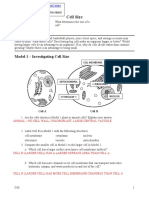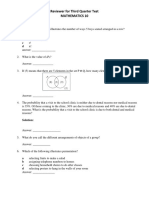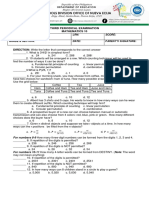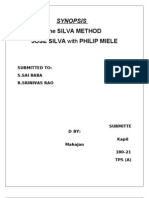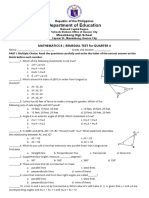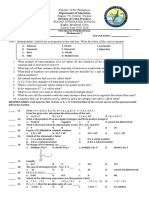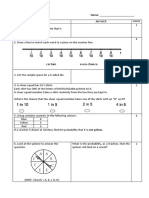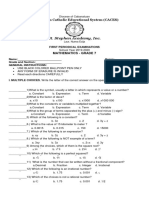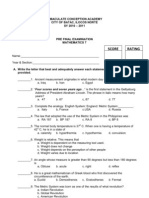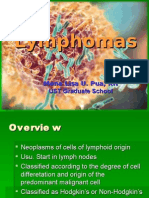BISC202 PracticeEXM 1
BISC202 PracticeEXM 1
Uploaded by
Layomi Dele-DareCopyright:
Available Formats
BISC202 PracticeEXM 1
BISC202 PracticeEXM 1
Uploaded by
Layomi Dele-DareOriginal Description:
Copyright
Available Formats
Share this document
Did you find this document useful?
Is this content inappropriate?
Copyright:
Available Formats
BISC202 PracticeEXM 1
BISC202 PracticeEXM 1
Uploaded by
Layomi Dele-DareCopyright:
Available Formats
Name: ________________ Student number: ________________
BISC 202 (Genetics) Midterm 1
Please fill in your name and student number on each page (just in case a page goes missing). If you require extra space, use the last empty page (but number your answers). Please read all of the questions carefully and do the easy ones first. Make sure your answers are clear and legible. If you use pencil, we cannot consider regrades.
Name______________________________ Multiple choice _______/28 Q8 _______/12 Q9 _______/15 Q10 ______/15 Q11 ______/18 Q12______ /12 Total _______/100
Student number____________________
Multiple choice (circle one correct answer per question) 4 points each x 7= 28 points 1. If the genes assort independently, a selfed monohybrid plant characteristically produces progeny genotypes in the ratio a. 1:1 b. 1:2:1 c. 3:1 d. 9:3:3:1 e. 1:1:1:1 2. From the cross of a AaBbccDdee female to a AabbCcDdEe, what proportion of the progeny will be genotypically identical to the female parent? (Assume independent assortment) a. 1/8 b. 1/16 c. 1/32 d. 1/4 e. 1/64 3. A process that occurs in meiosis, but not in mitosis is: a. cell division b. chromatid formation c. chromosome condensation (shortening) d. pairing of homologues e. chromosome movement to the poles 4. With respect to X-linked genes in Drosophila and humans, males are said to be a. homozygous b. hemizygous c. in cis d. in trans e. heterozygous 5. Why do scientists use chi square analysis? a. To prove their data are true 95% of the time b. To prove that two genes are linked c. To test the chance that their data are false d. To prove that their data are consistent with their hypothesis
Name______________________________
Student number____________________
6. What is Mendels first law? a. Definition of dominance versus recessiveness b. Independent assortment c. Equal segregation of alleles d. X-linked inheritance versus autosomal inheritance 7. How many different types of gametes can an individual with the genotype AaBBccDdEeFf form? a. 4 b. 12 c. 16 d. 64 e. 256 8. (12 points) In Drosophila melanogaster (fruit fly), the M/m and R/r allele pairs are found on the same chromosome pair 12 map units apart. The following cross was made: M m females r R x m m r r
tester males
a. What progeny genotypes are expected and in what proportions? (8 points)
b. If the above cross was performed in reciprocal (i.e. dihybrid males crossed to homozygous recessive females), what progeny genotypes would you expect and in what proportions? (2 points)
c. Why would you expect the results for a and b to be different? (2 points)
Name______________________________
Student number____________________
9. (15 points) Using the data shown below, determine the genotypes of the parental plants by analyzing the phenotypes affecting flower colour (blue or white) or pod shape (pointy or rounded) in the progeny from each cross (i-iii). Use C and c to designate the dominant and recessive alleles for colour and S or s to designate the dominant and recessive alleles for shape. Parents: i. blue, pointed x blue, pointed Progeny 3/4 blue, pointed 1/4 white, pointed 6/16 white, pointed 2/16 white, rounded 6/16 blue, pointed 2/16 blue, rounded 1/4 blue, pointed 1/4 blue, rounded 1/4 white, pointed 1/4 white, rounded
ii. blue, pointed x white, pointed
iii. blue, pointed x white, rounded
a. Which phenotypes are caused by dominant alleles? __________________________________ (3 points) b. Fill in the genotypes for the parents in each cross: (12 points) i. _____________________X ___________________
ii. _____________________X ___________________
iii. _____________________X ___________________ 10. (15 points) The following pedigree is of a family with an extremely rare genetic disorder. Assume that no new mutations have arisen in the pedigree. I II III IV 1 2 3 4 5 6
a. What is the mode of inheritance of this trait (i.e. dominant versus recessive/X-linked versus
autosomal)? Justify your answer. (5 points) 4
Name______________________________
Student number____________________
b. Using M for the dominant allele and m for the recessive allele, assign genotypes to all eight individuals in generation III (you can do this on the pedigree diagram) (4 points) c. If the two cousins IV-4 and IV-5 marry, what is the probability that their first child will express the trait. Show your calculation. (6 points)
11. (18 points) Suppose you have three linked genes with alternate alleles in a pea plant: a versus +; b versus + and c versus + (in each case, the wildtype allele is dominant). You test cross a pea plant known to be heterozygous for all three loci and obtain the following results: + a a a + + + a + b + + b b + b + + c + c + c c 379 39 81 2 3 74 36 386 1000
a. a. What is the order of these genes on the chromosome (explain your reasoning for full marks)? (3 points)
b. Construct a linkage map showing the relationship of the genes to each other and the map distances between them, showing all your work. (12 points)
c. Calculate the coefficient of coincidence and interference. (3 points)
Name______________________________
Student number____________________
12. (12 points) The following tetrads were produced by a cross of a Neurospora strain that had white spores (w) and a nutritional requirement for the amino acid arginine (arg) with a strain that had dark spores and no arginine requirement. spore pairs 1-2 3-4 5-6 7-8 number Tetrads 3 w arg + arg + + w + 15
1 w arg w arg + + + + 58
2 w arg w + + arg + + 14
4 w arg + + + arg w + 2
5 w+ w+ + arg + arg 1 total= 100
6 w+ + + w arg + arg 10
a. What is the map distance between the arg locus and the centromere? (show your work) (4 points)
b. What is the map distance between the w and arg loci? (show your work) (4 points)
c. Are the arg and w loci on the same or different arm of the chromosome? (Be clear about how you arrived at your conclusion.) (4 points)
Name______________________________
Student number____________________
You might also like
- Midterm Exam in Statistics and Probability (Grade 11)Document2 pagesMidterm Exam in Statistics and Probability (Grade 11)Magz Magan95% (58)
- POGIL Cell Size-KEYDocument5 pagesPOGIL Cell Size-KEYKali Warnke100% (1)
- Reviewer G10 Math Q3Document6 pagesReviewer G10 Math Q3Rudyr Bacolod67% (9)
- Periodical Exam Math 7Document2 pagesPeriodical Exam Math 7laarni malata95% (19)
- Math 6 - First Quarter First Long TestDocument5 pagesMath 6 - First Quarter First Long TestJon Jon D. Marcos100% (1)
- Test (40 Marks) : Statistics and ProbabilityDocument8 pagesTest (40 Marks) : Statistics and Probabilityapi-445198464No ratings yet
- GRADE 10 3rd Quarter MATHDocument5 pagesGRADE 10 3rd Quarter MATHMyra Ramirez Ramos0% (2)
- The Silva MethodDocument8 pagesThe Silva Methoddivyenk75% (4)
- Free Chapter - Recovery - From - Training PDFDocument24 pagesFree Chapter - Recovery - From - Training PDFSzigmund100% (1)
- 10 Science Notes 06 Life Processes 11Document13 pages10 Science Notes 06 Life Processes 11rajkumar trivedi100% (4)
- Kids Maths Grade 7 Test Questions 2010 07Document8 pagesKids Maths Grade 7 Test Questions 2010 07urkerNo ratings yet
- GenesDocument4 pagesGenesLittle AlligatorNo ratings yet
- A. Y. Jackson S. S. Mathematics Test Mdm4U Permutations and CombinationsDocument5 pagesA. Y. Jackson S. S. Mathematics Test Mdm4U Permutations and CombinationsfunkerdudeNo ratings yet
- Electrical Engineering Network EE Quizzers' Pool Statistics CategoryDocument1 pageElectrical Engineering Network EE Quizzers' Pool Statistics CategoryJimmyorajayNo ratings yet
- Quarterly 10Document2 pagesQuarterly 10Hanna Grace HonradeNo ratings yet
- Math 30-2 Unit Exam (#2) (Written Only)Document5 pagesMath 30-2 Unit Exam (#2) (Written Only)Anand UnnithanNo ratings yet
- Third Q Test StatisticsDocument6 pagesThird Q Test StatisticsMichaelle BunaoNo ratings yet
- Prim Maths 5 2ed TR Unit 8 Test PDFDocument2 pagesPrim Maths 5 2ed TR Unit 8 Test PDFBenjamin NealNo ratings yet
- 14 W Termtest1Document9 pages14 W Termtest1Riasat AzimNo ratings yet
- Math 8 Remedial Test Quarter 4Document2 pagesMath 8 Remedial Test Quarter 4Rose PanganNo ratings yet
- Introduction To Statistics CompleteDocument3 pagesIntroduction To Statistics CompleteNati PUFFxKIDNo ratings yet
- Chapter 13 Notes Part 1Document10 pagesChapter 13 Notes Part 1api-292320998No ratings yet
- Term 2 Cumulative PretestDocument2 pagesTerm 2 Cumulative Pretestapi-266347623No ratings yet
- Test Questionnaire - Basic Statistics and ProbabilityDocument2 pagesTest Questionnaire - Basic Statistics and ProbabilityVanessa G. ManguilimotanNo ratings yet
- MENDELIAN GENETICS WorksheetDocument1 pageMENDELIAN GENETICS WorksheetFlamingPlayz YTNo ratings yet
- Math in The Modern WorldDocument3 pagesMath in The Modern WorldMary Knoll PenalosaNo ratings yet
- Jomarie CaelasDocument3 pagesJomarie Caelasapi-276829441No ratings yet
- Mathematic 8: 2 Quarter Quiz #1 For Week 1 & 2 Name: - Section: - ScoreDocument2 pagesMathematic 8: 2 Quarter Quiz #1 For Week 1 & 2 Name: - Section: - ScoreMARIA CARMELA MALIGAYANo ratings yet
- Grade 3 Mathematics Second Term TestDocument6 pagesGrade 3 Mathematics Second Term TestPatrius KerrNo ratings yet
- Exam - 3 Example With Factorial Design)Document7 pagesExam - 3 Example With Factorial Design)fielclarettetongolNo ratings yet
- Midterm Exam in GEC 4 BSCSDocument4 pagesMidterm Exam in GEC 4 BSCSRex GamingNo ratings yet
- Quiz 3 PermutationDocument2 pagesQuiz 3 Permutationdiana.monterdeNo ratings yet
- Unit 3 Homework All in OneDocument11 pagesUnit 3 Homework All in OneOuzamJatoiNo ratings yet
- Midterm Exam in Statistics and Probability Grade 11Document3 pagesMidterm Exam in Statistics and Probability Grade 11Shimmeridel EspañolaNo ratings yet
- VCTest 1 BF09 AnsDocument9 pagesVCTest 1 BF09 AnsDerick OrNo ratings yet
- Saint James Academy, Inc.: Test I. Multiple ChoiceDocument2 pagesSaint James Academy, Inc.: Test I. Multiple ChoiceMeace Javier Gallinero DrilonNo ratings yet
- Department of Education Division of Cebu ProvinceDocument5 pagesDepartment of Education Division of Cebu ProvinceMaria Bebe Jean PableoNo ratings yet
- Worksheet 1.3Document1 pageWorksheet 1.3Youtube clips and stuffNo ratings yet
- Math 8 - First Monthly TestDocument3 pagesMath 8 - First Monthly TestAliyah Monique BenitezNo ratings yet
- 18Uit1A1 - Statistical Methods Unit IDocument18 pages18Uit1A1 - Statistical Methods Unit ISuganthi PrakashNo ratings yet
- Yr 8 Probability PaperDocument4 pagesYr 8 Probability Paperapi-4171473750% (2)
- DNA Structure and Replication HW Packet - K-R - 12-13 - KEYDocument4 pagesDNA Structure and Replication HW Packet - K-R - 12-13 - KEYjersonmunoz923No ratings yet
- Summative Test in Math2Document1 pageSummative Test in Math2Riza Pearl LlonaNo ratings yet
- Department of Education: Quarter 2 Teacher-Made Summative Assessment in Mathematics 8Document2 pagesDepartment of Education: Quarter 2 Teacher-Made Summative Assessment in Mathematics 8be cutiesNo ratings yet
- CLASS 6 maths 1 + 2Document2 pagesCLASS 6 maths 1 + 2yayaminardnyuydzeNo ratings yet
- Rev Stat LearnersDocument4 pagesRev Stat LearnersApril Joy Pahilagao PoblacionNo ratings yet
- PT G8 MathematicsDocument4 pagesPT G8 MathematicsMrs. Myren GalauraNo ratings yet
- Practice Test in StatisticsDocument3 pagesPractice Test in StatisticsJoy Cabato Bayno100% (2)
- Genetics Unit TestDocument6 pagesGenetics Unit Testapi-311983424No ratings yet
- Activity 3 - SetDocument1 pageActivity 3 - SetMa. Editha I. BernardoNo ratings yet
- Revision Term 1 2023-2024Document14 pagesRevision Term 1 2023-2024mohammed Ali Mohammed al ghanimNo ratings yet
- St. Stephen Academy, Inc.: Cabanatuan Catholic Educational System (CACES)Document4 pagesSt. Stephen Academy, Inc.: Cabanatuan Catholic Educational System (CACES)Angelique VicenteNo ratings yet
- Final Term Review Sheet P1Document17 pagesFinal Term Review Sheet P1omaranwer215No ratings yet
- 8th Monthly ExamDocument15 pages8th Monthly ExamChenee FerolinoNo ratings yet
- Daily Warm Ups 5th Grade - PPTX (PDFDrive)Document73 pagesDaily Warm Ups 5th Grade - PPTX (PDFDrive)Eva WangNo ratings yet
- Math 8 - 4th Quarter ExaminationDocument3 pagesMath 8 - 4th Quarter ExaminationmaanramonNo ratings yet
- Divine Grace Montessori and High School, Inc.: FOURTH Quarterly AssessmentDocument4 pagesDivine Grace Montessori and High School, Inc.: FOURTH Quarterly AssessmentSharlyn BalgoaNo ratings yet
- JJDocument4 pagesJJAjo Sjeaony TeancealNo ratings yet
- About: Diagnostic TestDocument5 pagesAbout: Diagnostic TestTubaron Azul BekcasNo ratings yet
- SETS QuestionnaireDocument5 pagesSETS QuestionnaireYuan MarcusNo ratings yet
- 2Document5 pages2sqr42m5wx2No ratings yet
- Biology: The Science of Life: Prepared By: Mrs. Ethel O. Cueto, RNDDocument14 pagesBiology: The Science of Life: Prepared By: Mrs. Ethel O. Cueto, RNDnikki abalosNo ratings yet
- PSY3051 Perception Lecture 1Document9 pagesPSY3051 Perception Lecture 1DeclanNo ratings yet
- Cos - Chapter 9 Nail Structure and GrowthDocument2 pagesCos - Chapter 9 Nail Structure and GrowthAlexis O'SullivanNo ratings yet
- GB A Taste of TemptationDocument14 pagesGB A Taste of TemptationBridges IsidroNo ratings yet
- Suture Material and SuturingDocument63 pagesSuture Material and SuturinganggNo ratings yet
- Temperature Pulse and Respiration Rate Chart: RR PR TempDocument4 pagesTemperature Pulse and Respiration Rate Chart: RR PR TempShaine BalverdeNo ratings yet
- Plant Water Relations: Absorption, Transport and Control MechanismsDocument29 pagesPlant Water Relations: Absorption, Transport and Control MechanismsQamar AfzalNo ratings yet
- Brief Fatigue InventoryDocument1 pageBrief Fatigue InventorylaurachirodeaNo ratings yet
- Sepsis: Sepsis and Septic ShockDocument22 pagesSepsis: Sepsis and Septic ShockWialda Dwi rodyahNo ratings yet
- Ent MCQ'S 2Document37 pagesEnt MCQ'S 2Adham YounesNo ratings yet
- Pathophysiology: Helen Nonye Henry-UnaezeDocument7 pagesPathophysiology: Helen Nonye Henry-UnaezeVeronika Ayu Puspita NingrumNo ratings yet
- Laboratory Activity 8Document4 pagesLaboratory Activity 8Christland De jesusNo ratings yet
- Psychoneuroimmunology and Stress 3145127Document4 pagesPsychoneuroimmunology and Stress 3145127Alina ALiNo ratings yet
- Amino Acid Analysis Using ZORBAX Eclipse AAA ColumnsDocument10 pagesAmino Acid Analysis Using ZORBAX Eclipse AAA ColumnsMuhammad KhairulnizamNo ratings yet
- AP Biology Vocabulary TermsDocument41 pagesAP Biology Vocabulary Termsqazedc159No ratings yet
- Lymphomas With PathophysiologyDocument30 pagesLymphomas With Pathophysiologymabec pagaduan91% (11)
- BSC Nursing Year 2Document43 pagesBSC Nursing Year 2Kishan PatelNo ratings yet
- Module 6. Levels of Biological OrganizationDocument2 pagesModule 6. Levels of Biological OrganizationPretty SwanNo ratings yet
- Principles of Medical MicrobiologyDocument98 pagesPrinciples of Medical MicrobiologyJoshua MedinaNo ratings yet
- Todos Los Archivos de 2 Gts Squirtung Master y 2 DocumentoDocument10 pagesTodos Los Archivos de 2 Gts Squirtung Master y 2 DocumentoFederico Ceferino BrizuelaNo ratings yet
- Respiratory SystemDocument4 pagesRespiratory SystemAlloiza CaguiclaNo ratings yet
- Collagen PDFDocument6 pagesCollagen PDFayudewintasariNo ratings yet
- Lesson9 Cardiovascular AssessmentDocument21 pagesLesson9 Cardiovascular AssessmentDennis Nabor Muñoz, RN,RMNo ratings yet
- Healing Mcqs ExplainedDocument3 pagesHealing Mcqs Explainedsaad awanNo ratings yet
- Pathophysiology of PneumoniaDocument2 pagesPathophysiology of PneumoniaJeffrey Ramos100% (1)
- 1 ReadingInTheBrain PPT StanisDocument43 pages1 ReadingInTheBrain PPT StanisJuan Camilo Osorio AlcaldeNo ratings yet

